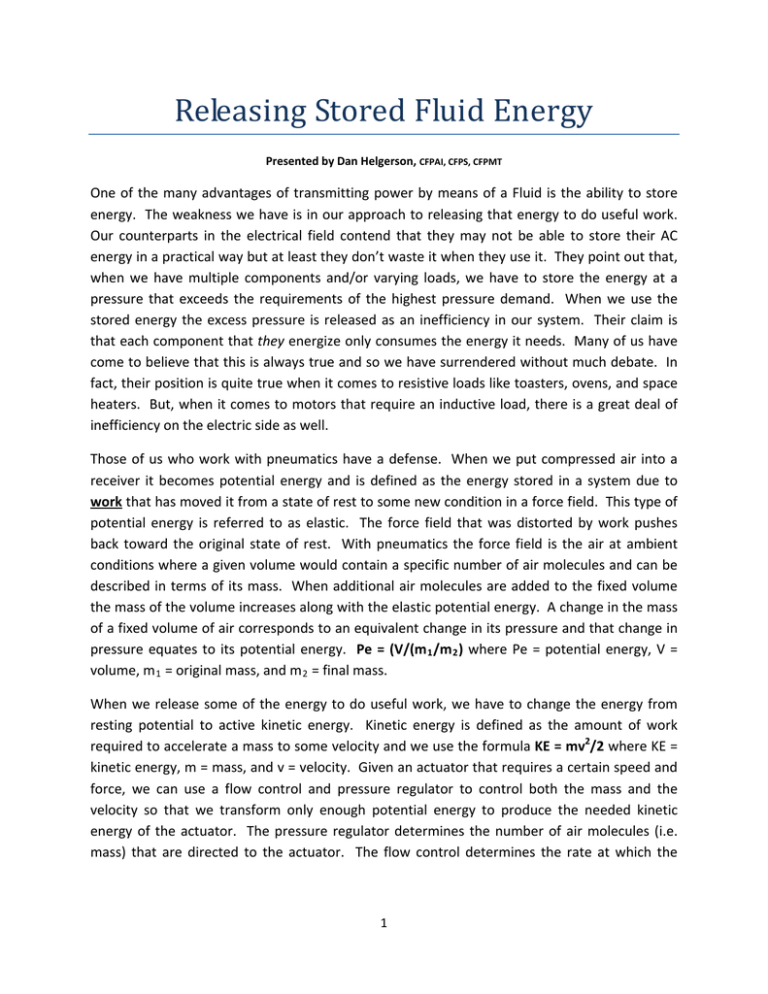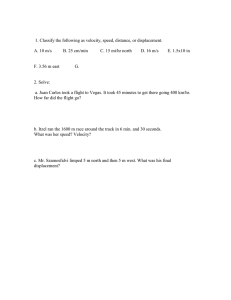Releasing Stored Fluid Energy
advertisement

Releasing Stored Fluid Energy Presented by Dan Helgerson, CFPAI, CFPS, CFPMT One of the many advantages of transmitting power by means of a Fluid is the ability to store energy. The weakness we have is in our approach to releasing that energy to do useful work. Our counterparts in the electrical field contend that they may not be able to store their AC energy in a practical way but at least they don’t waste it when they use it. They point out that, when we have multiple components and/or varying loads, we have to store the energy at a pressure that exceeds the requirements of the highest pressure demand. When we use the stored energy the excess pressure is released as an inefficiency in our system. Their claim is that each component that they energize only consumes the energy it needs. Many of us have come to believe that this is always true and so we have surrendered without much debate. In fact, their position is quite true when it comes to resistive loads like toasters, ovens, and space heaters. But, when it comes to motors that require an inductive load, there is a great deal of inefficiency on the electric side as well. Those of us who work with pneumatics have a defense. When we put compressed air into a receiver it becomes potential energy and is defined as the energy stored in a system due to work that has moved it from a state of rest to some new condition in a force field. This type of potential energy is referred to as elastic. The force field that was distorted by work pushes back toward the original state of rest. With pneumatics the force field is the air at ambient conditions where a given volume would contain a specific number of air molecules and can be described in terms of its mass. When additional air molecules are added to the fixed volume the mass of the volume increases along with the elastic potential energy. A change in the mass of a fixed volume of air corresponds to an equivalent change in its pressure and that change in pressure equates to its potential energy. Pe = (V/(m 1 /m 2 ) where Pe = potential energy, V = volume, m 1 = original mass, and m 2 = final mass. When we release some of the energy to do useful work, we have to change the energy from resting potential to active kinetic energy. Kinetic energy is defined as the amount of work required to accelerate a mass to some velocity and we use the formula KE = mv2/2 where KE = kinetic energy, m = mass, and v = velocity. Given an actuator that requires a certain speed and force, we can use a flow control and pressure regulator to control both the mass and the velocity so that we transform only enough potential energy to produce the needed kinetic energy of the actuator. The pressure regulator determines the number of air molecules (i.e. mass) that are directed to the actuator. The flow control determines the rate at which the 1 molecules flow (i.e. velocity). With pneumatics we have the ability to efficiently use stored energy. The major energy losses with pneumatics are the heat of compression and bad habits. But we are going to be discussing hydraulics. Hydraulics has advantages over both electricity and pneumatics in its power density and stiffness. There are a number of ways to store hydraulic energy without a significant loss due to the heat of compression even when using a gas accumulator for the elastic potential energy. The problem comes when we release the energy to do useful work. As stated earlier, we typically store hydraulic energy at a pressure that is higher than the maximum system requirement. If we have a pressure need of 70 bar and we store hydraulic energy at 70 bar, we will simply have a static condition; no useful work can be done. Storing the energy at 210 bar will provide a lot of potential energy but it cannot be efficiently released in the same way as compressed air. There is a reason for that. Hydraulic fluid is relatively incompressible. That means that a fixed volume of fluid has a given mass that we cannot control. The potential energy in stored hydraulic fluid can be found in the formula Pe = p a x m where Pe = potential energy, p a = absolute pressure, and m = mass. When a fixed volume hydraulic actuator needs to transmit kinetic energy, a specific mass at a certain velocity has to be directed to it. However, since the stored potential energy is higher than what is required to produce the required kinetic energy, if left unchecked, it would lead to an unacceptable acceleration. A pressure compensated flow control addresses the acceleration problem but at a cost. The flow control produces a deceleration force in the path of the fluid mass to limit the acceleration of the actuator. It plucks out the excess potential energy as heat and allows only the energy needed for the actuator to flow down-stream. We cannot limit the mass as it flows out of storage. What we can control is the extent to which we use flow controls and the demands that the actuators have on the stored energy. We need to change our focus from the accumulator and flow control to the actuators. We need to find a way to have the actuators respond to the stored potential energy so that they require all the pressure available and alter the mass requirement based on the kinetic energy needed. We will then dramatically reduce the losses we normally see when releasing stored hydraulic energy. This will be the focus of our discussion. Flow Augmenter: We will see how a simple positive displacement flow device can be used to translate high pressure into lower pressure without significant energy loss. 2 Flow Divider: We will examine how the same simple displacement device can be used to efficiently divide flow directed to actuators. Flow Augmenter with Variable Displacement and Feedback: We will see how adding a variable displacement component will improve the efficiency even more. Using a Variable Displacement Motor to Replace an Electric Motor: We will build the mathematical model to show how a variable displacement motor can be used to match the available pressure to the demand load so that a single source of high pressure fluid can be used to supply multiple motors, each with varying loads, and without an excess energy loss. For any given Torque, there is a discrete product of displacement and pressure. For any given Power at a fixed RPM there is a discrete product of displacement and pressure. 3



